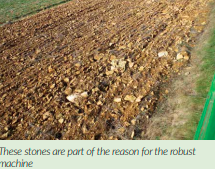Mike Donovan writes…
Joel Williams is a familiar face to many with an interest in soil health and biology, and first spoke to a UK farming audience in 2010. The Australian plant and soil health educator has a global audience and Direct Driller magazine caught him at the Overbury Estate in Worcestershire where he joined the estate manager and no-till enthusiast Jake Freestone and also Simon Cowell, a long term no-tiller who farms heavy land in Essex who was voted Soil Farmer of the Year 2018. The day provided a mass of information both in the field and from the podium for farmers thinking of transitioning to no-till as well as others who have already made the change. The event was superbly organised by QLF, quality liquid feeds, who have developed the foliar product Boost which is used by both featured farmers.
Joel provides workshops and consultation on soil management, plant nutrition and integrated approaches of sustainable food production as well as giving soil-based talks for farmers, advisors and others. At university he specialised in plant and soil dynamics and he has a particular interest in managing soil microbial ecology along with crop & soil nutrition to optimise plant immunity, soil function and soil carbon sequestration.
In the last few years he has been working in the UK and Europe with both conventional and organic farming systems, integrating soil chemical & biological assessments and in addition integrating plant nutritional analyses as a joined-up strategy for managing crop production. In the UK he was a headline presenter at the 2018 Groundswell Show in Herts and in the year did two presentations in Herefordshire and others in Sussex and Derbyshire, Haddington and Perthshire in Scotland, Northumberland , Shropshire and Tullamore, Ireland. He has enthusiastic audiences in Australia, UK, Ireland, Netherlands, Latvia, South Africa, Kenya, Canada and the US.
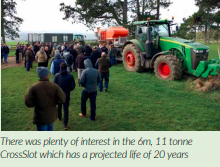
At the podium Joel is a convincing speaker who talks with his hands, while in the field he is often in the bottom of a soil pit explaining what is revealed to an audience around the edge. Soil, its use and misuse, is his passion but the MSc he is currently doing in Canada is in the wider area of Food Policy, illustrating his belief in the need to acquire a wide knowledge of the whole business of food supply. Joel has a wide understanding of the issues surrounding soil, the way farmers use it its biology and science.
The breadth of knowledge means that he has a suite of soil subjects within his expertise. “We live in exciting times in farming, as the industrial, ecological and agrarian factors of farming overlap to produce production systems, and the question of ecology is introduced at any part of the spectrum.” The third is ecology which is described by diversity conservation and the ecosystem. This is the leg which Joel considers most neglected. While the industrial or conventional farming contributes to the deterioration of soil components, including water quality and sustainability, the agrarian system relies on natural processes. Joel spends time exploring the area between the two, proposing farmers maximise the use of the natural processes which the farmer can harness to substitute for a proportion of artificial inputs.
Plant nutrient sources and supply
There are two basic sources: chemical and natural. Soil health is the provider of natural sources of nutrients, so the farmer who understands the mechanism of soil will have the tools to stimulate natural organisms that improve nutrient production. Soil health equals plant health and vice versa. Plants absorb nutrients fast, foliar feed getting to the roots in about an hour. Farmers using foliar products are advised to spray in the early morning for best take up.
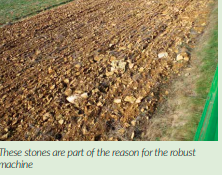
Joel explains that the UK, along with many other countries, has a history of over-application of nutrients, and says this is due to a focus on N, P and K and a disregard micro-nutrients and a casual interest trace elements. He explains that all components are needed if the soil’s potential is to be made available for the crops being grown. Smaller quantities of micro-nutrients may be needed, but their importance is equal to other elements. Healthy soil with adequate supplies of Mo, Fe, Ni and Co are able to feed healthy bacteria that are able to sequester N from the air as well as creating the right growing conditions for N fixing legumes and clovers. The science applies to all plants, and he stressed the importance of molybdenum.
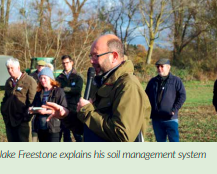
Tissue tests can mislead. Testing for total N doesn’t reveal levels of amino acid and the tests can show an N deficiency when the actual problem is in the trace and micro elements. Adding N from the bag will be far less efficient Soil biology is combined with soil physics and soil chemistry in creating a productive medium for crop growth, and Joel underlines the importance of all three, and explains that each has an influence on the other two. Chemical changes affect the physical structure as well as the biological activities; physical changes like compaction affect the biology and the chemistry… Joel focusses on soil biology because it is less well understood than the others.
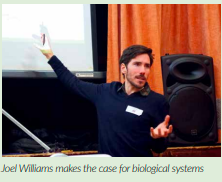
Most are aware of the huge number of living organisms, from the primitive algae which are the first form of life, to bacteria and fungi, protozoa (the single-celled microscopic animals, which include amoebas, flagellates, ciliates, sporozoans, and many other forms); nematodes; arthropods which include spiders and other invertebrate insects; other insects like centipedes and others; and earthworms. Soil carries billions of organisms which work together in what is called the soil food web, where carbon is the common denominator. Bacteria and fungi break down the organic matter by feeding on it and incorporate it into their biomass.
Up the chain and the critters are feeding on organic carbon and excreting it, breaking it down. At the top of the chain are creatures which eat each other producing dung for bacteria and fungi to enjoy. Mycorrhizal fungi is of major importance for plants as they are attached to the roots and contribute to plant development by being fed the sugars and carbohydrates which are the product of photosynthesis and in return feeding the roots mineral and organic nutrients needed for plant growth. Mycorrhizal fungi exist in nearly all soils and provide a secondary root system for the plant, a wider and efficient network attached to the plant’s roots with spreading spidery arms extending beyond the plant roots. These fungi can increase the plants access to soil volume from ten to a thousand percent, and so increasing water absorption, plant size and production.
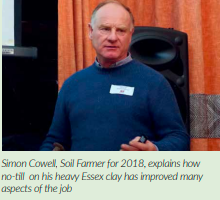
Further up the chain the protozoa
Nematodes are well know to farmers and growers. Root feeding ones feed on the sugars from roots having first punctured the root with a stylus. Beneficial ones scoop up bacteria and feed on it, others feed on fungi having a straw like structure,and others again that feed on other nematodes. Each process excretes waste products which are then available to the the plants. The process creates nutrients which can be measured and analysed. Some nutrients are highly soluble and almost instantly available to the plant once connected to the root structure. Less available are the exchangeable nutrients which will take a short time to become available.
The third category, the insoluble ones, can move down the soil strata and will, in time, change their nature and become available. When a soil test shows a deficiency of soluble nutrient the temptation to add more from the bag is compelling, but in reality the soil may well have enough nutrient, but lack the means of accessing it. More biological activity would bring the nutrients above the root zone and closer to the surface to allocation where they can be used.
Farm tour of Overbury
The group of 90 toured the higher land at Overbury and Jake Freestone explained that the management moved towards no-till in 2003 and has since taken up cover cropping and companion planting. The first field we saw has been no-till since 2012 and undressed Cruse wheat was coming through well. The crop had some Zn and Mg and 15 t/ha of FYM in addition to the pea residue. Blackgrass populations are in decline and the aim is rouse minimal insecticides. One of the visiting farmers named Ken put forward the idea that their neighbours’ use of the product provides protection, but Jake’s view is that as soil condition improves so the crop condition is raised and so become stronger and more resistant to insect damage. Rotational grass is used to clean land. They use a soil penetrometer to measure soil compaction and provide some comparative data of soil resistance at differing depths, and on the day of the visit we found that there was little difference between measurements in and out of the tramline. They also measure water infiltration using a drain pipe
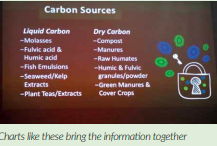
The three tractors and tour trailers climbed right to the top of Bredon Hill passing a large area of stoney brash to where the 6m CrossSlot direct drill was parked. Jake explained that the hugely robust machine was designed for New Zealand conditions where farmers were regularly tackling stony ground, and the expense was justified by the expected 20 year lifetime of the machine. The drill can handle four products at a time, with two hoppers with air, so it can do a main crop and granular fertiliser. Two side pods are used for small seeds, slug pellets and other product that is spread at a low rate. The drill weighs 11 tonnes and the tractor 9t, and the fuel is 13 – 15 litres /ha. Jake’s straw policy varies with the field. It is baled and removed before osr because of the slug challenge.
Simon Cowell, judged Soil Farmer of the Year for 2018 provided a fascinating account of working some of the heaviest clay on the Essex coast. His farming has involved working with soil to improve plant performance, and this has involved numerous trials of ideas he thinks might work. The result is that his growing medium has improved hugely. “The soil has lost its stickiness and it is 20 years since we have applied any phosphate. The farm carried a dairy herd and after each grazing we would put on some more nitrogen, just as we were told to do. Grass now grows as well without the top dressing of N.
Simon explained the plant hierarchy and how their nutritional needs change dependent on their place in the list. Moving the soil composition up the scale through the use of compost has resulted in a noticeable reduction in blackgrass which has been a major problem on these bacterial soils. The compost has reduced the germination of weed seeds and has meant that Atlantis is now working again. Simon says that the no-till system keeps the soil aerobic, while working these soils with tines and power harrows breaks the structure and causes slumping.
“I see the compost heap providing an inoculant rather than a fertiliser or soil conditioner. The compost provides a home for good bacteria and fungi which then help feed the cash crop.” The compost is mixed with a bespoke machine rather than a fork and the stirring increases both carbon and nitrogen levels. The heap is kept at 70C and is left to stand for a year. He makes the most of horse compost, ditch soil and plasterboard. Fed this way the crops tend to have stronger straw, deeper roots while plots given regular fertiliser have softer tissue making it easier for destructive fungi and insects to attack.
Every field has a ‘holiday’ by being down to lucerne for three years. The crop goes to local company Dengie crop driers and the plants get a chance to drive their roots deep into the soil – they can go as deep as 45ft and more. While conventional farmers would break up the root network created by these roots, by leaving them well alone Simon preserves the matrix of pores which aid drainage and provide new roots with a highway rich in fungi and bacteria from the rotting roots. The field surfaces are better able to carry farm traffic and the need for ultra flotation tyres is now much reduced. Simon also trialled the effect of fungicides – stopping using them on some fields – and found they were depressing yields. So while they reduced disease they had side effects.
He also has developed his own wheat mix blend, choosing 4 varieties that are unrelated and mixing them prior to drilling. The next year’s crop comes from home saved seed, and this has now continued for five years. He was interested in how this mix compared with seed from KWS and was pleased to see his mix performed well. He has done other trials into N and concludes that often the plant needs a combination of trace elements and bacteria in addition to the N feed. “The processes we are dealing with are far far more complex that is presented in textbooks and by experts.” Simon describes the trials as ‘addictive’ and the information gained is always worth more than the money spend on doing the work.
